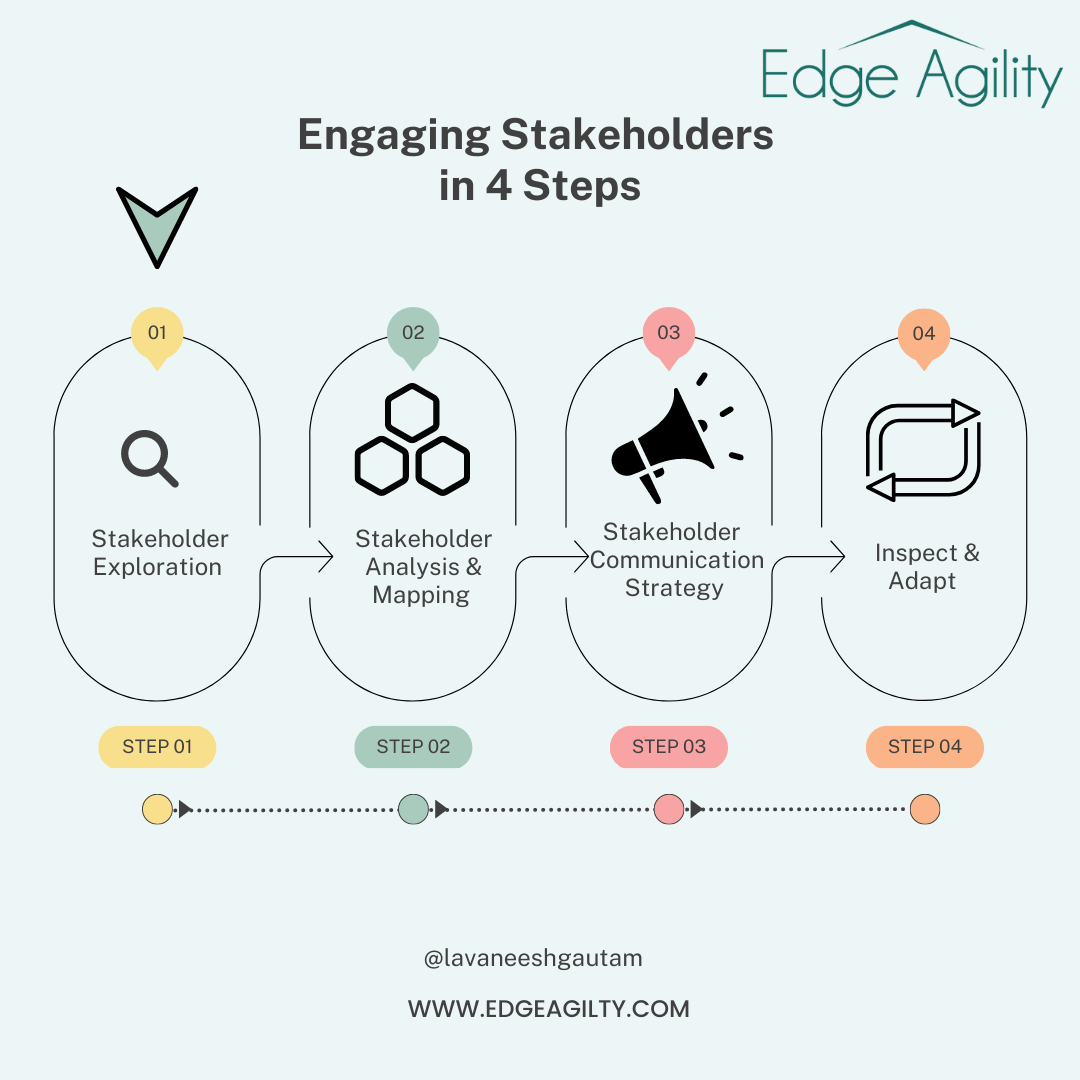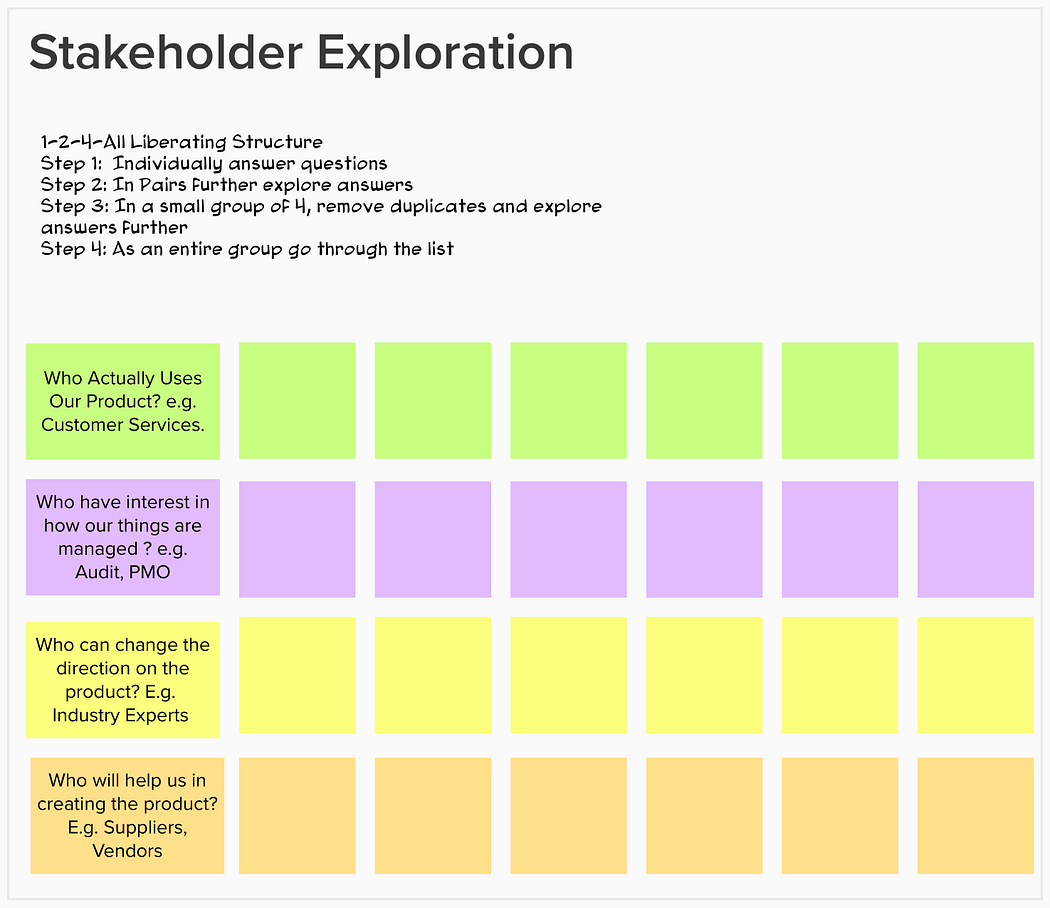Effective Stakeholder Engagement is key to the success of the product and one of the essential skills all product people should have. This article is part 1 of the Effective Stakeholder Engagement series.

I consider successful Stakeholder Engagement as a 4 Step process, which include:
- Stakeholder Exploration
- Stakeholder Analysis & Mapping
- Stakeholder Communication Strategy
- Inspect & Adapt
In this article, I will cover Step 1 — Stakeholder Exploration.

“Stakeholder.” What does It Mean?
Product leaders can’t know everything and they need help for the success of the product in delivering value to customers or users. This is where stakeholders come in.
A stakeholder is a very broad term and many people define it differently. To me it’s, “Anyone who directly or indirectly affects the decision making, and directly or indirectly related or affected by decisions taken.” They play a huge role in the success and failure of the products.
Stakeholder: ‘anyone who is directly/indirectly affects the decision making OR directly/indirectly related or affected by decisions taken’.
For example:
- PMO or Finance department in a company can affect how the budget has been used, this can impact how much we can build. Once you have made some decisions they also want to know about how you are spending the budget.
-
The Customer Service department is affected by the quality of the products or features we build. Sometimes they can also be a great source of customer feedback and can help us in making decisions.
- Users of your product are directly affected by the features incorporated in the product. Why and how they use products or features directly impact product decisions.

“Stakeholder Engagement” What Does It Mean?
Stakeholder Engagement is about identifying the right people for the right time, understanding their involvement with the product and managing them accordingly.
The list of stakeholders can be pretty big. If we start treating all stakeholders alike and engaging them the same way, we will be wasting a lot of entire time in meetings, giving status or updates, collecting wish lists, etc. Hence, having a robust Stakeholder Engagement strategy is not a ‘nice to have’ skill but a ‘must have’ skill.
For Product Owners/Managers, effective Stakeholder Engagement is not a ‘nice to have’ skill but a ‘must have’ skill.
Stakeholder Engagement is the process of effectively communicating and engaging with stakeholders. This requires understanding their needs, and problems. You need to work together to achieve the common goal for the product. Stakeholder Engagement involves managing expectations and balancing conflicting interests to ensure the product is valuable.
Stakeholders are people who gain or loose something when a product delivers certain outcomes. Effective Stakeholders Engagement can be the best way to reduce the risk of building something that nobody wants.
Pre-requisite For Stakeholder Engagement: Product Strategy
You cannot have robust stakeholder engagement without understanding your business or product strategy. Your strategy defines your key value propositions, and target customer segments. More importantly, how businesses will benefit from providing value to customers and users.
Without this context, stakeholder engagement can be just a tick-box activity or an activity without a purpose.
Product Strategy helps us in the identification of medium to long-term product goals or objectives. Without clear product goals or objectives, stakeholder engagement can be really difficult and mostly flawed. Every stakeholder request turns into an emergency. This may result in slowed decision-making, context switches, more meetings and more reports.
Stakeholder Engagement Strategy exist to support the Business/Product strategy rather other way round.
There are a few techniques to build a good Business or Product Strategy:
- Business Model Canvas by Strategyzer: It is a simple way to visualise and communicate business/product strategy. You can find the template of this at https://www.strategyzer.com/canvas/business-model-canvas.
- Lean Canvas by LeanStack: Very similar to Business Model canvas. Learn more about it here: https://leanstack.com/lean-canvas
- Product Vision Board by Roman Pichler. Another simple yet effective tool for visualisation and collaboration. Learn more about it here: https://www.romanpichler.com/blog/the-product-vision-board/
- Having a Product Strategy can’t be the goal. Aim for exploration and discovery. These tools trigger a few very good questions. Use these questions to have better clarity about your strategy.
- Don’t create a strategy in a silo. Involve your team members and stakeholders.
- Customers, their needs, and technology change over time as we learn more. Hence, regularly validate the product strategy with your team and stakeholders. You should regularly ask the questions: Is this product strategy still valid? Have we learnt something new which will make changes to the product strategy ‘Does this strategy require some changes?
Stakeholder Exploration
So where to find stakeholders? Who should be responsible for finding them? Although the Product Owner or Manager will be the key person to identify stakeholders, my recommendation would be to use the entire team. This will help team members to understand the stakeholders better.

Stakeholder Exploration Session
I am a great fan of Liberating Structures and use them a lot for group facilitations. In this technique, I use 1–2–4-All. I love to run a Stakeholder Exploration Session with the team. Generally, it takes 2–4 hours.
Using the 1–2–4-All, together we ask a few questions ourselves:
- Who are the Users? Think about who uses the product. Whose problem are we solving? For this make sure you are not only limited to external users. Think about internal users as well. For example, if we are building a banking application system, this will not only be used by customers but also by Credit, Fraud, Payments, Debt Management, and Customer Service teams. Identify who takes decisions for these internal users as well. Many times these could be managers or leaders in that specific part of the business.
- Who wants to know how things are managed? Many people are not users but their job is to ensure we are doing things right. They want to know: if we are on the right track and if we are meeting certain business expectations. They may not be interested in the features and functionality of the product but in compliance, budget, benefits realisation, etc. For example, Internal Audit. If you work in an industry that can be impacted by regulations, you know how important it can be to meet audit expectations.
- Who can change the direction of the product? These could be people who can provide the innovation which can cause the change in the direction of the product. For example, a CTO or Technical Expert of an organisation can drive a big push towards cloud technology and this can change the way products feature are delivered by developers and used by users. Sometimes, industry regulators also change the direction of products by imposing ground breaking laws. These sometimes are sources of innovation.
- Who will help us in creating the product? These could be people who help us in creating products and services. Many organisations and product teams are not self-sufficient. They need help from other teams, departments, suppliers and vendors to deliver products and services. For example, an organisation has outsourced User Discovery to a design agency. This design agency will be an important stakeholder.
Do you have any thoughts in regard to the above-mentioned? Are there aspects of stakeholder exploration which you’ve encountered that have presented unique challenges? If yes, feel free to share in the comments.
In the next article I will share my thoughts on Stakeholder Analysis & Mapping.
To learn more about Stakeholder Engagement, please join Scrum.org PSPO or PSPO-A classes.
from Scrum.org Blog https://ift.tt/RZYJiVy


0 Comments